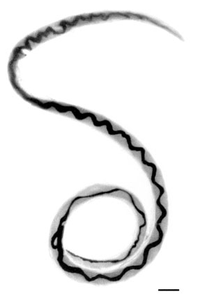
Photo from wikipedia
Abstract We investigated parasitic zoonoses caused by protozoans and helminths in urban and peri-urban rat populations (Rattus norvegicus and R. rattus) in Spanish cities. Rats were trapped and then dissected… Click to show full abstract
Abstract We investigated parasitic zoonoses caused by protozoans and helminths in urban and peri-urban rat populations (Rattus norvegicus and R. rattus) in Spanish cities. Rats were trapped and then dissected to remove adult helminths, and the contents of the large intestine were retrieved for the study of parasitic forms. The Midi Parasep® solvent free (SF) technique was used to concentrate the parasites in the intestinal contents. Some of the rats studied (n = 8) were infected by the rat lungworm, Angiostongylus cantonensis, whose first stage larvae (L1) are shed in rat faeces. After the concentration technique, L1 larvae were found in the sediment of 6 of the 8 positive rats. The two negative sediment samples were due to the presence of either only adult females or, in addition to males, only young females in the lungs of the rats. In view of our results, Midi Parasep® SF turned out to be a simple, rapid, inexpensive, and sensitive method to detect nematode larvae, such as the L1 larvae of A. cantonensis (or A. costaricensis), in natural and experimentally infected rats.
Journal Title: Journal of Helminthology
Year Published: 2023
Link to full text (if available)
Share on Social Media: Sign Up to like & get
recommendations!